Baeza
Baeza (Spanish pronunciation: [baˈeθa]), formerly also written as Baéza,[2] is an Andalusian town in the province of Jaén in southern Spain. It lies perched on a cliff in the Loma de Úbeda, the range separating the Guadalquivir River to its south from the Guadalimar to its north. It is now principally famed for having some of the best-preserved examples of Italian Renaissance architecture in Spain. Along with Úbeda, it was added to UNESCO's list of World Heritage Sites in 2003. The former Visigothic bishopric of Baeza remains a Latin Catholic titular see.
Baeza | |
|---|---|
 | |
.svg.png) Flag .svg.png) Coat of arms | |
 Baeza Location in Andalusia | |
| Coordinates: 37°59′N 3°28′W | |
| Country | |
| Autonomous community | |
| Province | Jaén |
| Comarca | La Loma |
| Judicial district | Baeza |
| Government | |
| • Mayor | Leocadio Marín Rodríguez (PSOE) |
| Area | |
| • Total | 194.3 km2 (75.0 sq mi) |
| Elevation | 769 m (2,523 ft) |
| Population (2018)[1] | |
| • Total | 15,902 |
| • Density | 82/km2 (210/sq mi) |
| Demonym(s) | Baezanos |
| Time zone | UTC+1 (CET) |
| • Summer (DST) | UTC+2 (CEST) |
| Postal code | 23440 |
| Website | Official website |
| Part of | Renaissance Monumental Ensembles of Úbeda and Baeza |
| Criteria | Cultural: (ii), (iv) |
| Reference | 522rev-002 |
| Inscription | 2003 (27th session) |
| Area | 4.8 ha (12 acres) |
| Buffer zone | 176 ha (430 acres) |
History
The town stands at a high elevation about 3 miles (4.8 km) from the right bank of the Guadalquivir[3] in the Loma de Úbeda.[2] Under the Romans, the town was known as Beatia.[3] Following its conquest by the Visigoths, Beatia was the seat of a bishopric of Baeza (viz.). From the beginning of the VII century it was conquered by several Arab and berber states during the Al-Andalus period, being named Bayyasa.
The Christian diocese was reestablished in 1127 or 1147 following the town's conquest by Alfonso VII of Castile, but it was then still reconquered by the Almohads. After the Battle of Las Navas de Tolosa, Ferdinand III of Castile in 1227 takes the city and gives it the Fuero de Cuenca, a legislative corpus to facilitate the new castilian order and institutions. The diocese of Baeza was merged with Jaén in 1248[2] or 1249, but was later nominally restored as a titular see of the Roman Catholic Church.[4] With it, a University was founded as well, what shaped the cultural personality of the city in the following centuries to come. Also, two powerful families, Benavides and Carvajales, compite for power and determine the historical evolution of the city, situation that required the intervention of Isabel I of Castile at the end of the XV century.
The XVI century was the golden era of Baeza (and nearby Úbeda). It grew rich from several industries, notably textile, and the mentioned noble families, well connected with the Spanish Imperial state. They hired major architects of the era (including Andrés de Vandelvira) to design the present cathedral, churches, public buildings, and private palaces in the then-fashionable Italian style. The town's university building dates to 1533.[3] The city importance declined in the 17th century, with the only remaining industry consisting of local production of grain and olive oil. As few newer structures were built during this period, this had the effect of preserving the town's Renaissance legacy. The university closed for a time before being reopened by the 19th century[3] as a seminary. In the 1870s, the population was around 11,000;[3] over the next few decades, the Linares–Almeria railway was constructed nearby and town's population grew to 14,000 by 1900.[2]
Landmarks
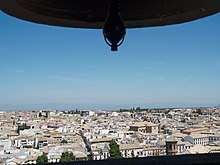

Baeza still houses several fine public buildings:
- Natividad de Nuestra Señora Cathedral, presents an early Gothic and Plateresque pilasters and crossed vaults finished in the XVI century in a Renaissance style by renamed architect Andŕes de Vandelvira, and since 1584 by architect and mathematician Juan Bautista Villalpando. The tower was redone in 1549 and the Chapel of St Michael was added in 1560.
- Town Hall (Ayuntamiento), a Plateresque building originally built as a combined courthouse and prison, leading to two separate main entrances
- Baeza University, established in 1533[3] or 1538, now a secondary school
- Santa Cruz Church, a Romanesque church with a two-aisle nave and semicircular apse. A side wall incorporates a Visigothic arch.
- St Paul's Church, a Gothic church with a Renaissance portal with a two-aisle nave and Gothic chapels. Includes the tomb of Pablo de Olavide.
- The Chapel of St Francis, in the ruins of a Renaissance building from 1538 formerly used as a monastery[2]
- Jabalquinto Palace (Palacio de Jabalquinto), including an Gothic entrance flanked by two cylindrical pilasters with Plateresque capitals with mocárabes ornamentation, a Renaissance courtyard, and a Baroque staircase
- Spain Plaza (Plaza de España)
- Constitution Plaza (Plaza or Paseo de la Constitucíon), including a marble fountain decorated with Caryatides[3]
- St Mary Fountain (1564)
- The Fountain of the Lions, from the Ibero-Roman ruins of Cástulo and possibly representing Himilce, wife of the Carthaginian general Hannibal
- The Úbeda Gate and Jaén[3] Gate.
- The Villalar Arch (Arco de Villalar), erected for Charles V's 1526 visit to honor his 1521 victory at Villalar.
- Seminary oratorio of St Philip Neri[3] (1660)
Transport
Baeza is 327 km (203 mi) south of Madrid by highway. The Linares–Baeza RENFE railway station is 15 km (9 mi) away to the southwest; it lies on the Linares-Almeria line. There are bus connections to Granada, Málaga, and Madrid. Granada (132 km or 82 mi) and Málaga (241 km or 150 mi) are the nearest international airports.
Notable locals
- Saro, bishop (c. 862)
- Domingo, bishop (1236–1249), Dominican friar, and former bishop of Marocco from 27 October 1225 – 1236
- Gaspar Becerra, sculptor and painter[5]
- St John of Ávila, Christian mystic[6][7]
- St John of the Cross, Christian mystic[8]
- Pablo de Olavide[9][10]
- Antonio Machado, modernist poet whose most notable prose work Juan de Mairena is thought to have been inspired by his time as a teacher in Baeza (1912–1919)
Gallery
- Palacio de Jabalquinto
- Iglesia de la Santa Cruz
- Iglesia de San Pablo
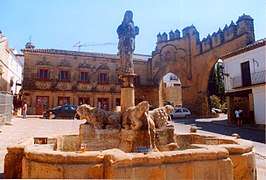 Fuente de los Leones
Fuente de los Leones- Fuente de Santa Maria
- Cattedrale
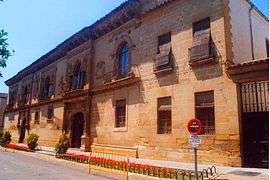 Ayuntamiento
Ayuntamiento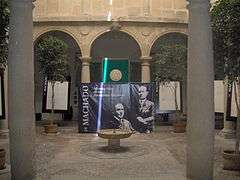 Council Seminary cloister, from Antonio Machado headquarter of International University of Andalusia
Council Seminary cloister, from Antonio Machado headquarter of International University of Andalusia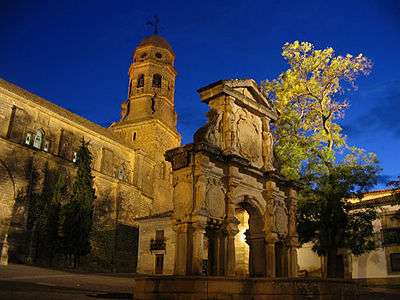 Santa María fountain and cathedral of Baeza
Santa María fountain and cathedral of Baeza
See also
Notes and references
- Municipal Register of Spain 2018. National Statistics Institute.
- EB (1911).
- EB (1878).
- Annuario Pontificio (in Latin), 2013, p. 847
- Rodríguez Rebollo, Ángel. "Gaspar Becerra". Diccionario biográfico español (in Spanish). Real Academia de la Historia. Archived from the original on 28 September 2019. Retrieved 29 September 2019.
- "Baeza homenajea a San Juan de Ávila". Diócesis de Jaén (in Spanish). 14 May 2009. Retrieved 29 September 2019.
- "San Juan de Ávila, más de cerca en Baeza". Diario Jaén (in Spanish). 18 July 2019. Retrieved 29 September 2019.
- Chicharro Chamorro, Dámaso (June 2018). "De nuevo sobre san Juan de la Cruz en Baeza: entre el colegio de san Basilio y la universidad ("El nido de los conversos)" (PDF). Boletín. Instituto de Estudios Giennenses (in Spanish): 353–383. ISSN 0561-3590. Retrieved 29 September 2019 – via Dialnet.
- Pozo Ruiz, Alfonso. "Pablo de Olavide y Jáuregui (Lima 1725-Baeza 1803)". Universidad de Sevilla (in Spanish). Retrieved 29 September 2019.
- "Pablo de Olavide y Jáuregui". Universidad Pablo de Olavide (in Spanish). Retrieved 29 September 2019.
- La Dépêche Du Midi. "Carcassonne se trouve une jumelle" (in French). Retrieved June 26, 2012.
Sources and external links
| Wikimedia Commons has media related to Baeza. |
- Official site for the municipal government
- "Renaissance Monumental Ensembles of Úbeda and Baeza", World Heritage Sites, UNESCO
- Ubeda and Baeza site
- Baeza, Spanish Ministry of Education, Culture and Sport
- "Baeza", GigaCatholic
- Romanesque church at Baeza
- Image Gallery of Baeza
- Baeza eGuide
- ebaeza.com eBaeza guide
Bibliography

- Chisholm, Hugh, ed. (1911), , Encyclopædia Britannica, 3 (11th ed.), Cambridge University Press, p. 191